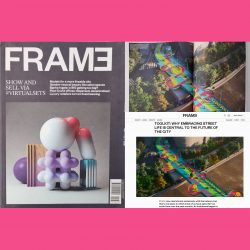
© 100architects
High Loop
Life Hub | Shanghai | China
High Loop is a proposal for the renovation of Puji Road pedestrian bridge in Shanghai, the iconic bridge over the Suzhou Creek that connects the districts of Zhabei and Jing’an.
Official Video | Youtube Channel
The Suzhou Creek is known to be a museum of bridges because of the large amount of those structures crossing over the creek. This one in particular was first built over the Suzhou Creek in 1997 for pedestrians only.
On 2009 for the World Expo of Shanghai, the bridge was renovated to allow access to small vehicles such bikes and scooters besides the pedestrians, improving the connectivity between Jing’an district and Zhabei district.
The bridge extends over a kilometer in length as an elevated platform offering unique urban views from one of the most representative areas of Shanghai.
However, it is currently underestimated when compared with other bridges crossing the Creek, hiding its uniqueness and amazing potential to become an urban landmark in Shanghai.
Our proposal aims to transform the bridge into an eventful elevated park crossing the city offering a unique urban journey through one of the densest areas of Shanghai. The grey asphalt gives way to bold and bright colors, turning the bridge into an eye-catching elevated urban landmark.
The design strategy of the High Loop organizes the different circulations by colors, creating a hierarchy of different rhythms and paces in which the bridge can be transited.
While a straight lane in electric lime color defines the fast track for bicycles and motorbikes, a winding path in viscous magenta color was purposely introduced to slow down the pedestrian circulation.
A contrasting loop that encourages pedestrians to take it slow, enjoy the journey and the privileged views over Shanghai’s urban landscape and the Suzhou Creek.
As background color, a soothing cyan blue defines the spaces to stop & stay, spaces to socialize, meet and gather. From viewing decks to picnic plazas, lounge areas or mini amphitheaters, it’s in these cyan blue pockets where all the contrasting yellow urban furniture and social functions are located, allowing the loop to wind around them, encouraging the appearance of those pockets.
In addition, new greenery planters are introduced, either as decorative elements or as functional separators of the motored track and the pedestrian path.
Besides those functions, some of the cyan blue patches have been purposely left empty in order to leave flexible spaces to keep allowing the occurrence of informal pop-up night markets and vendors commonly seen in the current version of the bridge.
The design does not change the current structure but rather transforms it by only adding a colorful painted scape and functional urban objects on top, improving circulation system and adding functional pocket.
Official trailer 1| Youtube Channel
Official trailer 2| Youtube Channel
Credits
PROJECT NAME: High Loop
DESIGN: 100 Architects (Shanghai)
DESIGN TEAM: Marcial Jesús, Javier González, Lara Broglio, Mónica Páez, Keith Gong, Cosima Jiang, Ponyo Zhao, Elena Michelutti, Ginger Huang
CLIENT: Undisclosed
SIZE: 1,000 m.
STATUS: Concept Design
LOCATION: Puji Road Bridge, Jing’an District, Shanghai (China)
About
High Loop
High Loop aims to transform the bridge into an eventful elevated public park crossing the city offering a unique urban journey through one of the densest areas of Shanghai turning the bridge into an eye-catching elevated urban landmark.
To know more click above!
More images
What is a neighborhood intervention?
This is the medium-scale type of intervention that takes place in the public realm of a city, related to the altering of a portion of a neighborhood. A type of intervention of such magnitude and notoriety impacts not only the immediate surrounding urban environment but rather the urban dynamics of a whole neighborhood, becoming an urban landmark and a local attractor of social interactions in a given neighborhood.
The main objective of this typology is to trigger massive public interest in the place through a strong visual impact and injection of activities, encouraging the increase of high public influx and establishing an urban landmark that can cultivate important human dynamics and boost commercial activity. These phenomena are achieved through the creation of spaces for leisure, entertainment, play and collective joy, catalyzing important social interactions throughout the neighborhood.
This topology of intervention, normally is used by real state developers to bring fresh and unique ideas to the public realm of their urban developments, which contributes to stand out in the market, establishing a distinct brand identity through innovative, and user-oriented design solutions that enhance the quality of life and thus, the appeal and value in the eyes of potential buyers or tenants, increasing the marketability of the project and potentially leading to higher property values, rental rates and ultimately faster sell out. This interventions maximize the value of the entire neighborhood.
Projects
insta100
Publications

100 Architects proposes to transform the Puji Road pedestrian bridge in Shanghai into 'an eventful elevated park'. The concept, High Loop, includes viewing decks, picnic plazas, lounge areas, mini amphitheatres and flexible spaces for informal pop-up night markets.